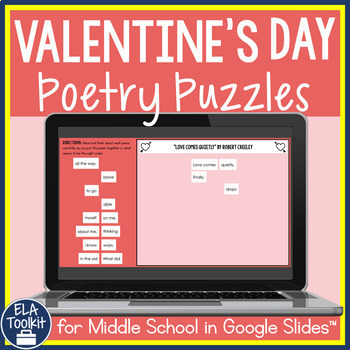Valentine's Day Poems Close Reading & Analysis | Drag & Drop Digital Love Poetry
- Google Drive™ folder

Also included in
- Have some fun with your middle school students this Valentine's Day while helping them strengthen their reading and writing skills! This bundle includes a hands-on close reading poetry analysis activity, a lesson on word choice inspired by a mentor text, and an engaging grammar and editing activityPrice $6.00Original Price $7.50Save $1.50
Description
Valentine's Day Poetry Puzzles are a fun, engaging way for students to practice close reading and poetry analysis. Middle school students will be actively engaged in this digital drag-and-drop activity as they read Valentine's Day poems closely, reread, and think critically to assemble the puzzle pieces in the correct order. Get ready for some thoughtful student-led text-based academic discussions about Valentine's Day poetry!
★ GET MORE FOR LESS ★ with the Holiday Digital Poetry Puzzles Bundle (coming soon!)
and ★ SAVE A BUNDLE ★ with the Valentine's Day ELA Bundle for Middle School!
WHAT'S INCLUDED
• Digital Poetry Puzzles with words and phrases from 5 Valentine's Day poems (see below)
• Differentiated: Each puzzle is provided at 3 levels of challenge
• No Prep: Simply assign the Google Slides™ to students and go!
• Answer Key: Teaching slides with completed puzzles
• User-friendly Teacher's Guide with detailed lesson plan, differentiation, and extensions
VALENTINE'S DAY POEMS
• Love Comes Quietly by Robert Creeley
• It's All I Have To Bring Today by Emily Dickinson
• [Do You Still Remember: Falling Stars] by Rainer Maria Rilke
• The Look by Sara Teasdale
• Ragtime by Kevin Young
⇒ Looking for more challenging poems? Click here for the high school version!
Please Note: This is a GOOGLE SLIDES™ resource. Looking for another format?
• Click here for Printable PDF
HOW IT WORKS
The Valentine's Day Poetry Puzzle activity helps students develop the habits and skills of close reading by requiring them to:
• Reread their poems multiple times
• Examine the poem’s diction and syntax closely
• Peel back the layers to uncover what the poem says, how the poem says it, and what the poem means
• Engage in deep text-based discussions
• Point to specific words and meanings in the poem as they justify and provide a rationale for their sequencing of the poetry pieces
WHY POETRY PUZZLES?
• These short Valentine's Day poems and excerpts are ideal complex texts for close reading practice.
• Students are motivated and engaged by the collaborative/competitive and puzzle-solving aspects of the activity.
• As they seek to figure out how the poetry pieces fit together, students must reread and closely analyze the text to determine what their individual poetry pieces mean and how those lines come together to convey the overall meaning of the poem.
• There are several options for the activity. You can have students work independently or with a partner, and differentiation is built in with three levels of challenge.
• Extension activities include creating visual images to enhance communication, reading aloud with fluency and expression, and researching the poet and/or poem.
COMMON CORE AND TEKS ALIGNED
• CCSS.CCRA.R.1 and CCSS.RL.6-8.1 Read closely to determine what the text says explicitly and make logical inferences from it; cite specific textual evidence
• CCSS.CCRA.R.4 and CCSS.RL.6-8.4 Interpret words and phrases as they are used in a text
• CCSS.CCRA.R.5 and CCSS.RL.6-8.5 Analyze the structure of texts, including how ... stanzas relate to each other and to the whole
• TEKS.LA.6-8.5.F Make inferences and use evidence to support understanding
• TEKS.LA.6-8.6.C Use text evidence to support an appropriate response
___________________________________________
YOU MAY ALSO LIKE
• Drag-and-Drop Activities
• Poetry Resources
• Discussion Resources
___________________________________________
➼ Get Half Price and FREE Resources! ★ CLICK HERE ★ to follow my store and hear about sales, freebies, and new resources, which are always 50% off for the first 48 hours!
➼ Earn TpT Credits! ★ CLICK HERE ★ to leave a review and earn credits to use on future TpT purchases.
Thank you for visiting the ELA Toolkit store! Please contact me if you have any questions or requests.
Take care, Honor @ ELA Toolkit






